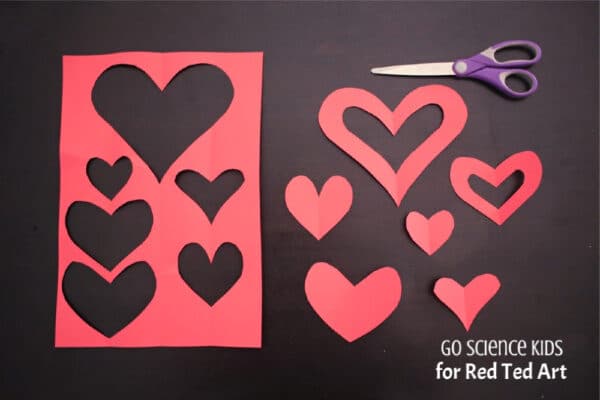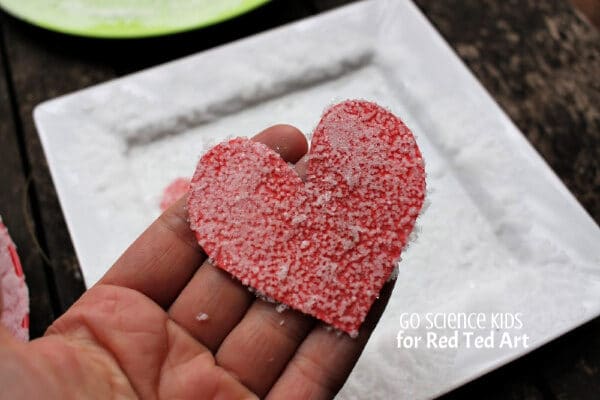Salt Crystal Hearts – STEAM Valentine’s Idea
Oooh today we combine two fabulous themes – STEAM Valentine’s Activities and fun Kids’ Valentine”s Day Crafts!
Welcoming Danya from Go Science Kids for the 31 Days of Love series!
Hi, I’m Danya, the geeky (& crafty) mum behind Go Science Kids. I’m so thrilled to be joining the Red Ted Art crew for this year’s 31 Days of Love!
Today I’m going to share with you how to make these Salt Crystal Hearts – they are a great way to combine a cute Valentine’s Day craft with hands-on science: a “science craft” as I like to call it!
Here’s how we made them.
Salt Crystal Hearts: Materials
- red paper
- scissors
- regular cooking or table salt
- hot water, glass & spoon
- shallow plates
- ribbon or nylon thread
- sticky tape
Salt Crystal Hearts: STEAM for kids instructions
1. Start by cutting out paper hearts. I find it easiest to fold the paper first, and cut half a heart shape from the fold, so that when it opens up it forms a symmetrical full heart shape.
2. Pour hot water into a glass – it doesn’t need to be boiling, especially if you are doing this with young kids. Stir in as much salt as will dissolve.
3. Using shallow plates, pour the salt water solution over the paper hearts. Let them sit somewhere undisturbed for several days, or until the water has dissolved. Salt crystals should have now formed all over your paper hearts (and plates).
4. Carefully remove your hearts from the plates, and flip over to tape a loop of ribbon or nylon thread on the other side.
Salt Crystal Hearts: The Science Explained
This is one of those science craft activities where you can delve into the science aspects as much or as little as you like!
If you are doing this craft with preschoolers, you might like to taste (a small amount) of the salt and the water, and predict what the salt water solution will taste like. Making salt water is a good way to introduce the concept that some things dissolve and others don’t. When the water evaporates and the salt ‘reappears’ again, you can demonstrate that, even though you couldn’t see it, it was there all along.
For early primary school kids, you might be able to talk about how salt is a solid, but when you mix it with water, it becomes a salt water solution. The salt crystals break apart and dissolve. Once we evaporate off the water, the salt reforms as salt crystals again. You could also talk about how our food salt comes from either evaporating seawater, or mined from old deposits. And that table salt and cooking salt is essentially the same thing, just perhaps with different levels of purity, and ground finer.
You could examine the newly formed salt crystals and notice that they are all cube shaped (which is one of the cool things about crystals; different types of crystals form in different shapes!)
Or for older primary school aged kids, you could turn this into a true experiment, by changing one of the variables and seeing how this effects the results. You could change the concentration of salt in the saltwater, perhaps?
I love how so many science conversations can stem from one simple science craft activity!
If you enjoyed this idea, you may want to check out some of our other activities on Go Science Kids. We have lots of cute “science craft” ideas, as well as a bunch of fun science experiments you can do in 10 minutes or less. You can sign up to our newsletter, and follow us over on Facebook too.
And may I say a big thank you to Maggy and Red Ted Art for hosting the 31 Days of Love series again this year! We *love* it!
Thank you Danya for joining us!!!
More great STEAM Projects for Valentine’s Day here:
Or how about our Hearts 101 collection?










